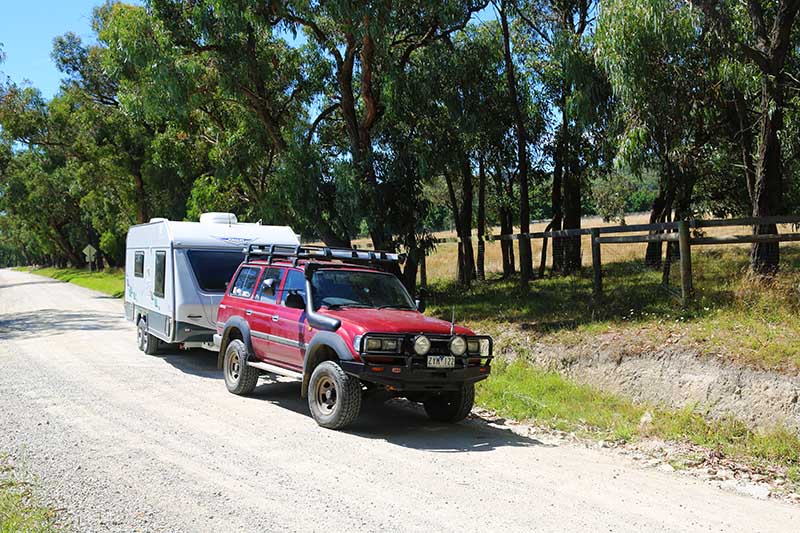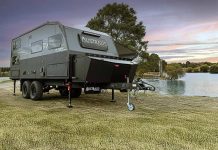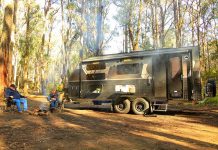Buying a caravan brings with it the temptation to also buy a new tow vehicle. That 22-footer isn’t going to tow itself, and the hatchback in the garage wouldn’t pull the skin off a rice pudding.
A new dual-cab ute or 4WD wagon will lighten the wallet by tens of thousands of dollars. Or at least $100,000 if you really want to go to town. But for us mere mortals, saddled with mortgages and raising children, such an outlay is unrealistic.
[If you like this article, Like Go RV on Facebook!]
The good news is, it doesn’t have to be a barrier to enjoying the RV lifestyle. If you really want to do it, you’ll find a way. This will probably require you to make compromises and to adjust your expectations. With that said, let’s look at the advantages of buying a second-hand tow tug.
BUDGET, BUDGET, BUDGET
The most important decision when searching for a used vehicle: your budget. Let’s assume a budget of $20K. For that money, you could get into an early 2000s Toyota Land Cruiser… with a big, hefty catch. The engine will probably have more than 300,000km on the clock and it will probably be a petrol or naturally-aspirated diesel. One will cost you a small fortune at the bowser, especially if your trailer is anything larger than a small camper trailer, and the other will be as slow as a wet week. There will also be very little left in your budget to account for unexpected mechanical repairs, registration costs and accessories (roof rack, awning, new tyres, etc.).
 In my opinion, these factors put the 100 Series out of reach. Again, it’s about adjusting expectations. If you have your heart set on a Cruiser, consider an earlier model. A mid-to-late 1990s model with similarly high kilometres could be found for between $8000 and $10,000, meaning the bulk of your budget could be spent on making the vehicle as mechanically reliable as possible. If you’re lucky, you’ll have enough left over to fit a new bull bar, all-terrain tyres, and even a roof rack.
In my opinion, these factors put the 100 Series out of reach. Again, it’s about adjusting expectations. If you have your heart set on a Cruiser, consider an earlier model. A mid-to-late 1990s model with similarly high kilometres could be found for between $8000 and $10,000, meaning the bulk of your budget could be spent on making the vehicle as mechanically reliable as possible. If you’re lucky, you’ll have enough left over to fit a new bull bar, all-terrain tyres, and even a roof rack.
Frankly, that’s a better scenario. But your vehicle will be used for towing and, no matter how well you’ve done, for the original outlay the vehicle’s engine still runs on petrol. When it comes to Cruisers, that’s just the way it is.
SPEAKING FROM EXPERIENCE
I love my Cruiser. It’s a 1993 model with the in-line six-cylinder petrol-guzzling engine. I bought it from a wholesaler in regional Victoria a number of years ago for under $9000. It had 237,000km on the dial, no rust, some fading paint, but it passed a mechanical inspection easily enough. Over the years, it’s had a head replacement – the mechanical equivalent of open-heart surgery – a new radiator fitted, and all sorts of smaller jobs done.
Nowadays, it’s as reliable as any new 4WD. It’s certainly not as comfortable and there are always niggling issues to attend to, but I’ve spent less than $20K (including on some accessories).
That said, the petrol engine – powerful enough to haul up to its towing capacity of 2500kg, albeit very slowly up steep hills – isn’t efficient. Towing around town, the needle drops quickly but, on the open highway at a steady 100km/h, a tank of fuel is good for about 450km.
THINK DIFFERENTLY
Get past the idea of badge loyalty. Toyotas, some would argue, fetch a high price because they’re, well, Toyotas. When it comes to Land Cruisers, there’s probably some truth to that. Why not consider something out of left field, such as a Land Rover Discovery? If you need a vehicle with a high towing capacity, an early model Disco might be a reasonable option. A 2.5L turbodiesel Discovery that’s done between 200,000km and 250,000km will cost you $5000 or less.
Undoubtedly, you’ll need to factor in mechanical repairs and upgrades, especially since the vehicle will be used for towing, but the starting price, compared to that of the Cruiser, has to tempt.
And the Disco example is just for starters. The Jeep Grand Cherokee is another. Between $6000 and $8000 will get you into a low-kilometre 2004/05 4.7L petrol Overland with automatic transmission. The eight cylinders will drink a lot of juice, especially when towing, but if it’s only used for short trips away, as opposed to a big lap, it might be a viable option.
WHAT’S THE POINT?
Where there’s a will, there’s a way. The second-hand vehicle market has more options than you might realise. And, while we all love shopping for a new car, the truth is that shopping for a second-hander can be just as exciting and, ultimately, more financially realistic.






I had a fantastic Ssangyong Rexton. That towed up to 2.3 ton. Fantastic to drive .7 Seater 5cylinder Mercedes motor 5 speed Gearbox. Fuel economy was great. About 6.7 klms per litre with plenty of power. That was with air-conditioned going at 100kph. I would highly recommend.
Had a 2003 jeep with the 5 cylinder merc engine, towed a tandem pop top no worries. Now on my b 3rd jeep
Have had a Hyundai Terracan 2.9l diesel in the past, tows to 2500 kg, seven seater, and now have a Kia Sorento, 2.5l diesel 5 speed auto, tow up to 2800kg. Fantastic vehicles picked my Kia up for less than $15g with 113,000km and done another 30,000 in the last 18 months, about 12,000 of that towing our 17ft, 1600kg Viscount. Great vehicles, often one owner and favored by older folk. When we were looking also found a terracan that was pristine, back seats were untouched as owned by older folks, under car was spotless and only 90,000 on the clock for around $12g. Both brilliant vehicles nothing like them selling nowadays both proper low range 4wds.
I own a 2004 Mitsubishi Challenger purchased private in 2015 with 47,000 klm on it. I tow a 16ft pop top and it is the most comfortable vehicle I’ve owned. Previously I had a 2001 Challenger LS and towed a 19’6″ caravan. They mightn’t be the fastest and flashiest on the road but I give them 10 out of 10
I’ve owned three Landrover Discos, the Series 2 with a 2.4 litre diesel, the series 3 with the 2.7 litre diesel and my current series 4 with the 3 litre diesel. All of them rated at 3.5 tonne towing capacity. Many long trips (Melbourne – Perth etc.) towing several vans up to a 2.7 tonne tare 30 footer at 16 litres per 100 kilometres. Last return trip with 1.7 tonne 27 footer at 9 litres per 100 kilometres. Both of my previous discos have stayed “in the extended family” and still going strong. I’ve done a lot of towing (and unhitched driving) in mine sites and the outback in Toyotas, Nissans and Mazdas. I now regularly tow a 4 tonne tipper trailer with my disco on my property (which has some pretty steep hills) the Disco handles it all without a problem. AS I say to the knockers. “Judge ’em when you’ve (really) used ’em”.
Hi Graeme Peterson,
I would like your advice, at present I have a 2006 Hyundai Terracan 2.9 Turbo Diesel, that I have owned from new. But like it’s owner is getting a bit long in the tooth, & is not as good as it used to be, especially when it comes to towing my 19″ 6′ , 2500kg van. So thanks to this article I have Discovered ( if you will excuse the pun), the Land Rover Discovery, so due to my limited finances I will be looking at about a 2005/2006 Series 3 SE, which with any luck I should be able to find for no more than $20000, & also with not to many kilometres on the clock. By that I mean under 250000. So what help & advice could you please give me. I have owned lots of vehicles, but so far although I have driven a few earlier Land Rover 110s. I have never owned one, so maybe I should enjoy one before it’s to late.
Many thanks Mike Sheridan
Anyone has a hyundia santa fe as a tow car.
I have a Honda CR-V 2.4 petrol 4WD 5 speed Auto that I have just purchased and I would like some information on towing a 1000kg Caravan. I believe it is legal but I wonder about performance with that engine capacity and auto transmission. David Eames.
I have a Hyundai Santa Fe 2009 R series 12.5 – 14.5 fuel consumption towing a 2000kg van. Now 9 years old never even replaced a light globe still on original brakes. Regular serving only.
Be careful of the Landrover Discovery. There are two timing belts one at the front and the other at the back on tdi models. Some tdi models require the body to be removed from the chassis to replace the back timing belt. Could you imagine the expense to carry out such a task.